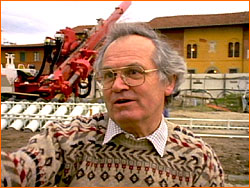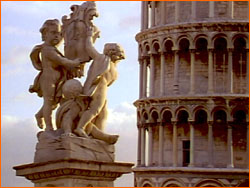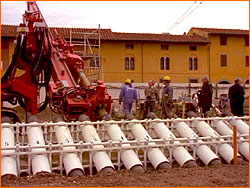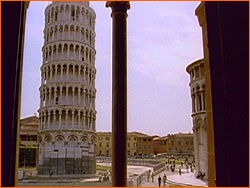
|
 |
 |
As of June 1999, the Leaning Tower of Pisa leaned an inch less than it had at the beginning of the year. It may sound like a small step for the tower, but it's a giant leap for the Pisa Commission in charge of saving the dangerously tilted structure. Here John Burland, a Commission member and professor of soil mechanics at London's Imperial College of Science, Technology, and Medicine, tells how perilously close the tower has come to toppling over, and about the painstakingly careful procedure to remove soil from beneath the north side of the tower to help ease it slightly back toward the vertical—and toward a stability it has not known for 300 years. NOVA: You've recently finished the preliminary soil extraction. Would you consider it a success? Burland: The whole operation has been very successful. The original intention was to see if we could move the tower a very small amount, about six millimeters. In fact, we moved it over 27 millimeters, or about an inch. Not only has the tower moved northwards, but the south side of the foundation has come up a little, which is a very positive result.
Burland: In a sense, the amount is immaterial. That's not what we were looking for. Since the soil-extraction method is a new thing, the uncertainty was: Would we get a positive response at all? We've got a tower that's literally on the point of falling over. We did everything we possibly could beforehand to check the method: by numerical analysis, closed-form analytical solutions, model tests, and then a large-scale trial. They all pointed to the fact that we would get a positive response. Nevertheless, we had to ask: Are we prepared to go in and try it on the tower? The Tower of Pisa is notorious for springing surprises on those who try and stabilize it. We bit the bullet, and the result has been positive. In fact, we moved the tower five times as much as we had originally intended. NOVA: How many years will you gain if all goes to plan? Burland: If we manage to reduce the inclination by a half a degree, or about half a meter at the top, which is our intention, then that would add at least 300 years to the life of the tower, assuming there were no other untoward events. NOVA: How does soil extraction work? Burland: It involves a special drill 200 mm in diameter, which drills down into the very soft soil just beneath the tower's foundations on the north side. The drill is designed so there's no disturbance to the ground on the way in, but when we pull it back out a bit, it leaves a cavity, which we have found closes very gently. As a result, the ground above it subsides a little bit and takes the tower with it. NOVA: How much soil do you actually extract? Burland: Each time we go in, we extract between 15 and 20 liters of soil. We can keep going into the same spot, or we can go in to other spots around the tower, which allows us to control exactly how much it moves each time. It's a very flexible, repeatable method.
Burland: Yes, we are literally steering it. If it goes a little bit to the east, we can take a little bit of soil out on the west side, and it comes west. Indeed, one of the great successes of this preliminary intervention was that we were able to control the east/west movement of the tower exactly as we wanted to. We wanted to bring it back to the west a couple of millimeters, and that's what we did. NOVA: What will the full intervention entail? Burland: It will be exactly the same method, but instead of using only 12 tubes, which is what we're using now—we can drill in 12 locations, which is only over a width of five meters or so—the full intervention would involve something like 40 tubes over the entire width of the tower, so that we could then evenly extract soil over its full width. That way, we can get a much larger response. We're aiming at something on the order of half a meter reduction in tilt. The present tilt is four and a half meters, so we'd be reducing it by about 10 percent. NOVA: Why wouldn't you go any further than that? Burland: Because you'd then start seeing it. Ten percent is barely visible, so tourists, unless they were making incredibly careful measurements, wouldn't really notice it. The Leaning Tower's not going to appear to be leaning any less. But if we took it much more than that, then both people living there and tourists would start saying, "Look, they're reducing the inclination of the tower."
Burland: Well, not quite that. But we'd start getting complaints, I think, and we don't want that. We think half a meter would be enough to stabilize the tower for hundreds of years at least, if not permanently, but it wouldn't be noticeable. And that's very important, that we don't really change the character of the monument. That would be quite wrong and quite inappropriate. NOVA: What is the rough cost of the full intervention? Burland: I think we're probably talking about two or three million pounds, perhaps a bit more. NOVA: So what are the Commission's long-term plans—in other words, after the full intervention? Burland: Well, there are a few things that still have to be done. We want to strengthen the masonry, which we'll probably do during the full under-excavation. If we left the tower alone after reducing its inclination, it's possible that it might start moving again. But there are ways of permanently stabilizing it after we've brought it back. We found that what is causing the tower to continue to move is a water table in the ground very near the surface that fluctuates seasonally—it goes up and down. We could develop a scheme to stabilize the water table. We would put what's called a diaphragm in the ground around the tower, some distance away, which would isolate the ground immediately beneath the tower from the water outside the diaphragm. It would create a sort of water-tight compartment around the tower, and that way, the water under the tower would not move seasonally because it would be trapped inside the diaphragm, and its level would be controlled by pumps and wells and so on. That's not an easy operation. It's not hazardous, but it's quite expensive and a bit time-consuming. Continue: Will the tower remain standing indefinitely? Pisa Panorama | Where it Stands Today | The Galileo Games Rescuing World Monuments | History of Interventions | Resources Teacher's Guide | Transcript | Site Map | Fall of the Leaning Tower Home Editor's Picks | Previous Sites | Join Us/E-mail | TV/Web Schedule About NOVA | Teachers | Site Map | Shop | Jobs | Search | To print PBS Online | NOVA Online | WGBH © | Updated November 2000 |
 John Burland stands before the soil-extracting device
that recently gave the Leaning Tower the lean it had
30 years ago.
John Burland stands before the soil-extracting device
that recently gave the Leaning Tower the lean it had
30 years ago.
 If all goes to plan, the Leaning Tower will lean
about a foot and a half less at the top than it does
now.
If all goes to plan, the Leaning Tower will lean
about a foot and a half less at the top than it does
now.
 In the so-called "full intervention," workers will
use up to 40 tubes like these to extract soil from
beneath the tower's north side, thereby causing the
tower to lean a bit less.
In the so-called "full intervention," workers will
use up to 40 tubes like these to extract soil from
beneath the tower's north side, thereby causing the
tower to lean a bit less.
 It would be "quite wrong and quite inappropriate,"
Burland says, if the tower were to lose its lean. The
Pisa Commission only seeks to lessen the angle by a
small amount.
It would be "quite wrong and quite inappropriate,"
Burland says, if the tower were to lose its lean. The
Pisa Commission only seeks to lessen the angle by a
small amount.